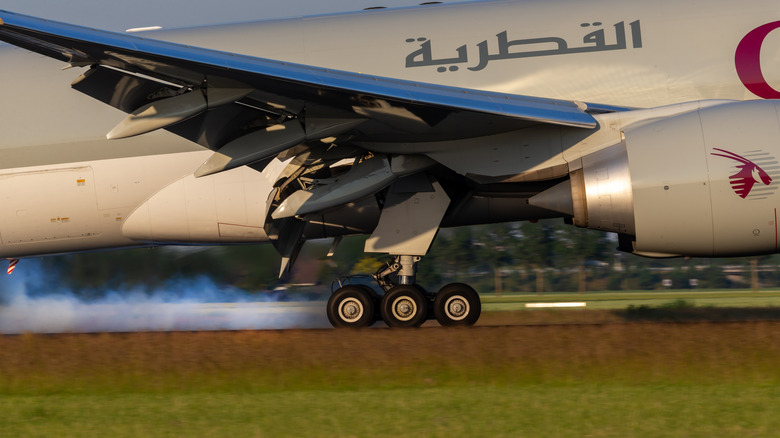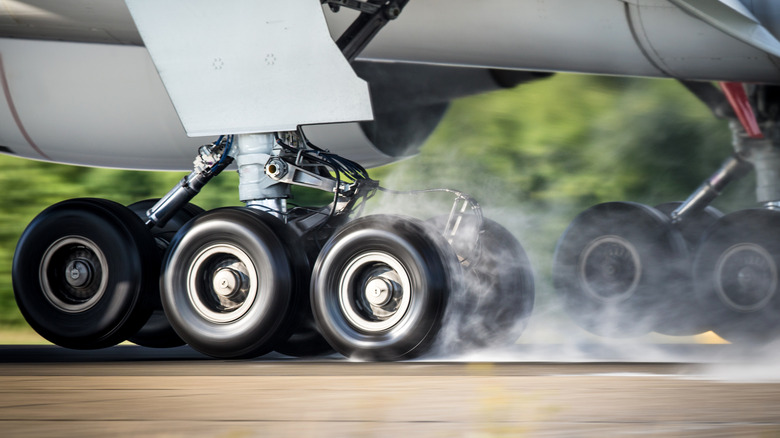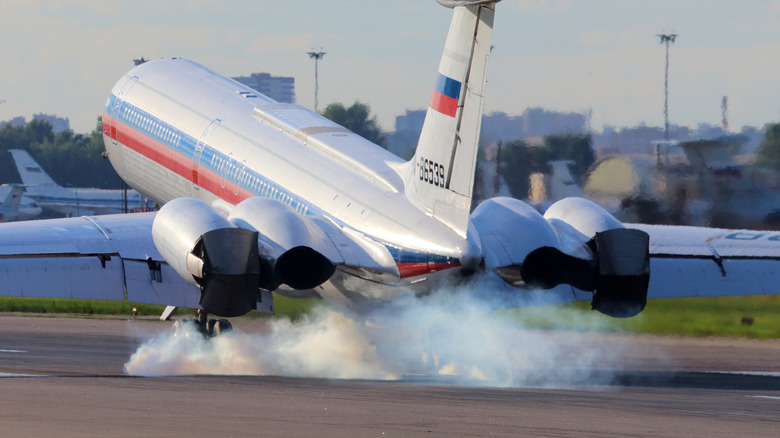How Hot Do Airplane Brakes Get And How Do They Avoid Brake Fade?
Stopping an airplane is no easy task, and although planes can use spoilers and thrust reversers to assist with the task, the brakes still do around 40% of the work. In simple terms, it's all about energy. An aircraft's wheel and brake system converts the kinetic energy of a landing plane to heat energy. In the case of large airliners like the Boeing 777 or Airbus A350, this is a lot of energy to be dissipated. At its most extreme, the Airbus A380 (the largest ever passenger plane) will land at speeds of between 149 mph and 155 mph, and has a maximum landing weight of a mind-boggling 862,007 pounds. That's a lot of energy to convert into heat, and it all happens incredibly quickly, causing a rapid thermal spike. This can cause the entire brake system to heat up to over 1,800 degrees Fahrenheit.
Managing this heat successfully is absolutely critical. Although modern brake rotors (usually carbon) are designed to withstand such temperatures, an excess of heat still has the potential to cause aircraft tires to explode or ignite any leaking hydraulic fluid. Another consequence of such temperatures is a phenomenon known as brake fade, this happens when brakes overheat, which can result in the brake pads and rotors no longer generating enough friction to adequately decelerate the aircraft. While all this might sound like a recipe for disaster, the engineering of brakes means failures are rare — let's take a closer look at how aircraft brakes work and safely cope with the demands of stopping a 200-ton aircraft.
Avoiding brake fade
A big part of how aircraft brakes withstand repeated high-energy stops is the materials that are used. The average car will use brake discs that are made from steel. However, when it comes to planes — especially larger planes like the aforementioned heavyweight A380 or Boeing 777 – carbon ceramic brakes are commonly used. There are two main reasons for this: the first is down to performance. Carbon brakes are far less susceptible to brake fade thanks to their ability to keep absorbing energy and therefore slow the aircraft at higher temperatures than traditional steel brakes.
While the use of these materials is definitely something that the passengers and crew should be happy about, it also has a secondary advantage that can keep airlines happy as well — carbon brakes are lighter than steel, and this weight reduction results in lower fuel consumption. For example, a Boeing 737 NG fitted with carbon brakes will weigh 700 pounds less than the same model with steel brakes. Over an aircraft's operational life, this can result in substantial savings.
However, even with the more advanced materials used in modern aircraft brakes, heat still builds up rapidly — and takes time to dissipate. This means that monitoring the temperature of the brakes is something that pilots always have to be aware of, a point that is especially relevant during short turnarounds.
Keeping it cool
Let's begin with a startling fact — the energy absorbed when a large airliner touches down is similar to the energy levels present in a lightning bolt. Brake systems must be designed to deal with all this energy and heat and do so without damaging the plane. However, there are also other factors that can contribute to overheating brakes, including a dragging brake, under-inflated tires, and rejected take-offs. To ensure that an airplane's brakes are safe to operate and within temperature limits, there are several safeguards that are built into modern aircraft.
One of these is an alarm system that monitors the temperature of the brakes and alerts pilots when temperatures are too high. In Boeing aircraft, the system is called 'Brake OVHT'; the Airbus equivalent is called 'Brake Hot'. These systems ensure that the brakes have cooled to an acceptable temperature for the plane to take-off. Some aircraft, including the heavyweight Airbus A380 and A330, are equipped with cooling fans to help dissipate the heat when the aircraft has touched down.
If high brake temperatures are expected when the aircraft has just taken off, then pilots can delay retracting the landing gear until the brakes have had a chance to cool down. Finally, the importance of regular maintenance and the replacement of worn-out parts is also critical to ensure that airplane brakes continue to work and passengers arrive — and stop — safely at their destination.


